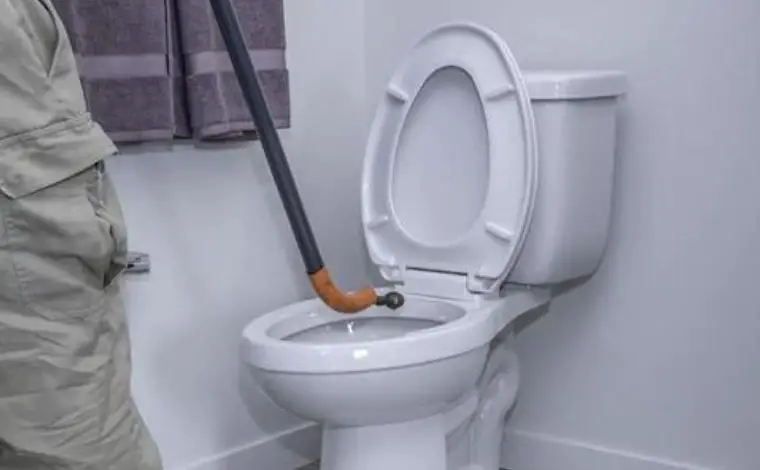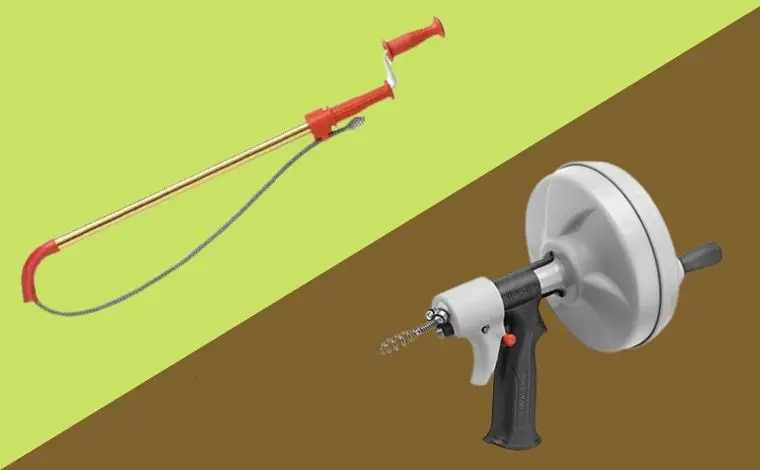We live in an age of ultimate convenience. From automatic toilets to touch-free faucets, modern bathroom technology has simplified life in countless ways. But even the most advanced plumbing systems can face one of the oldest household problems — clogs.
Whether it’s a toilet that refuses to flush properly, a sink that drains slowly, or a shower that fills up like a mini-bathtub, clogged pipes are both frustrating and unhygienic. They create unpleasant odors, standing water, and in severe cases, even overflow disasters.
Most people immediately think of calling a plumber — but what if you could fix the problem yourself in just a few minutes? The truth is, with the right tools and a little knowledge, you can easily unclog your toilet or drain without professional help.
Two of the most effective DIY tools for the job are the toilet auger and the drain snake. They may look similar, but they serve different purposes.
-
The toilet auger is designed specifically for toilets. It can reach deep blockages and break them apart without damaging the porcelain.
-
The drain snake, on the other hand, is used for smaller clogs in sinks, showers, and tubs. It’s flexible and lightweight but less powerful than the auger.
In this complete guide, you’ll learn:
-
What each tool does and how it works
-
When to use one over the other
-
Step-by-step instructions for proper use
-
Their pros, cons, and differences
-
Expert tips for keeping your plumbing clog-free
By the end, you’ll know exactly which tool to grab when your bathroom or kitchen drain starts acting up.
What Is a Toilet Auger and Why It’s a Must-Have Tool
A toilet auger, often called a closet auger, is a powerful hand tool designed to remove blockages in toilets. It consists of a long, coiled metal cable housed inside a rigid shaft, usually 3–6 feet long. The end features a curved rubber sleeve that protects your toilet bowl from scratches, and the handle lets you crank the cable forward into the drain.
How It Works
When you crank the handle, the metal coil travels through the toilet trapway. Once it hits a clog, you can rotate it to break up or hook the obstruction, then pull it back out. This mechanism is what makes an auger far more effective than a regular plunger.
When Should You Use a Toilet Auger?
Use a toilet auger when:
-
The plunger fails to clear the clog.
-
The toilet bowl fills up or drains very slowly.
-
You suspect a hard object (like a toy or sanitary product) is stuck inside.
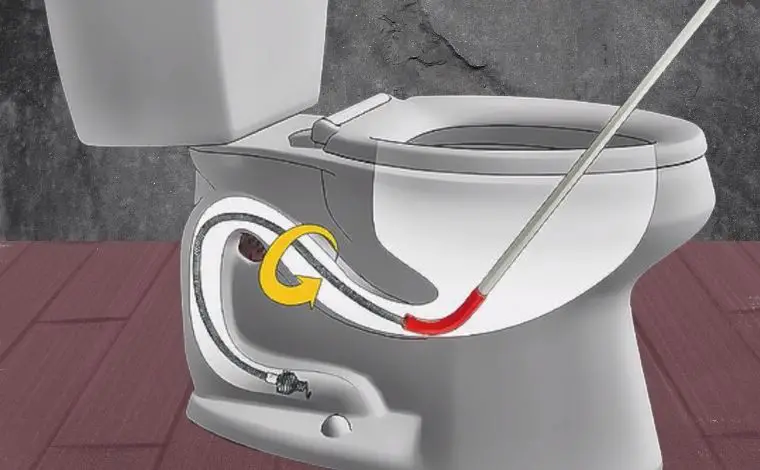
It’s safe for all types of toilets — from traditional gravity-flush models to modern dual-flush or high-efficiency toilets.
Advantages and Drawbacks of a Toilet Auger
Advantages
-
Strong and Reliable:
Toilet augers are built with heavy-duty materials, capable of breaking down even the toughest clogs. -
Eco-Friendly Solution:
Unlike chemical drain cleaners, an auger doesn’t release toxins into your pipes or the environment. -
Cost-Saving Tool:
One purchase can save you hundreds of dollars in plumbing fees over time. -
Manual Power — No Electricity Needed:
Simply rotate the handle; no power source or battery is required. -
Prevents Pipe Damage:
The protective rubber coating ensures your porcelain toilet remains scratch-free.
Drawbacks
-
It can be slightly heavy or bulky compared to smaller tools.
-
Requires some physical effort to operate effectively.
-
Not suitable for unclogging sinks or narrow drains.
Still, if you want a long-term, reliable tool for tough toilet blockages, the auger is unbeatable.
Different Types of Toilet Augers Explained
Toilet augers come in various types, each designed for different needs. Let’s look at the most popular versions:
1. Manual Cable Auger (Standard Type)
This is the most common household version. It’s operated by hand using a simple crank. It’s affordable, durable, and perfect for small to medium blockages in toilets.
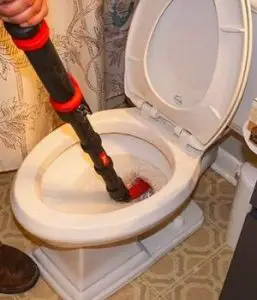 2. Power Auger (Electric Auger)
2. Power Auger (Electric Auger)
A motorized version of the auger, powered either by an electric drill or built-in motor. It rotates automatically, requiring minimal effort while providing strong torque for stubborn blockages. These are ideal for professionals or frequent DIYers.
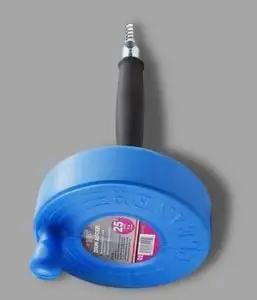 3. Drum Auger
3. Drum Auger
The drum auger stores a long metal cable inside a drum-shaped container. It often comes with an auto-feed system that helps guide the cable deeper into the pipe. Though bulkier, it’s perfect for long or twisted drain lines.
4. Rocket Nozzle Auger (Hydro Jet Auger)
This high-tech version uses pressurized water jets to blast through blockages. It’s the most effective but also the most expensive option, typically used by professionals for large or complex drainage systems.
How to Use a Toilet Auger (Step-by-Step Tutorial)
Follow these simple steps to use a toilet auger safely and efficiently:
Step 1: Prepare for the Task
-
Put on rubber gloves and a protective mask.
-
Lay old towels or newspapers around the base of the toilet to catch splashes.
-
Make sure there’s good lighting and proper ventilation.
Step 2: Insert the Auger into the Toilet
Position the rubber-sleeved end into the bowl’s drain opening. The rubber helps protect the porcelain surface from scratches.
Step 3: Crank the Handle
Start turning the handle clockwise. As you do, the cable moves deeper into the toilet trap. Keep cranking until you feel resistance—this indicates you’ve reached the clog.
Step 4: Break the Clog
Once the auger hits the obstruction, keep rotating to either hook or dislodge it. You’ll feel it loosen as the debris breaks apart or gets caught on the coil.
Step 5: Pull Out and Flush
Gently retract the cable, then flush the toilet to check if water drains freely. If it still drains slowly, repeat the process. You may use a plunger afterward for final clearing.
Pro Tip: Never use excessive force. If the auger feels jammed, retract and reinsert carefully to avoid damaging your pipes.
What Is a Drain Snake and When Should You Use It?
A drain snake (or plumbing snake) is another useful tool for unclogging drains, especially in sinks, bathtubs, and showers. It’s lighter and more flexible than a toilet auger, making it perfect for smaller pipes.
Design and Function
A typical drain snake is a long, coiled cable—metal or plastic—with a spiral tip. You insert it into the drain, rotate the handle, and either pull out or break up the clog. Some advanced snakes are motorized, using automatic feeds to make the job faster.
Why It’s Called a Snake
Because it “slithers” through your pipes, bending around curves and grabbing obstructions just like a snake catching its prey.
When to Use a Drain Snake
-
Slow-draining sinks or showers
-
Hair buildup in bathroom drains
-
Kitchen grease clogs
-
Soap scum or debris blocking small pipelines
It’s not ideal for toilets, as the thin cable can tangle or break inside the trapway.
Benefits and Limitations of Drain Snakes
Benefits
-
Affordable and Widely Available: Perfect for homeowners on a budget.
-
Lightweight and Compact: Easy to store and handle.
-
Versatile Use: Works for multiple fixtures—sinks, tubs, and shower drains.
-
Beginner-Friendly: Requires minimal effort to operate.
-
Environmentally Safe: No harsh chemicals involved.
Limitations
-
Not effective for large or deep clogs (like toilet obstructions).
-
Can bend or kink if over-rotated.
-
May not completely remove greasy buildup.
Despite these minor issues, a drain snake is a handy tool to keep for quick household maintenance.
How to Use a Drain Snake Like a Pro

Step 1: Remove the Drain Cover
Use a screwdriver or pliers to remove the cover or stopper. Clean any visible hair or debris near the surface.
Step 2: Insert the Snake
Feed the tip into the drain opening. Rotate the handle clockwise to help it travel further into the pipe. Don’t push too hard; let the coil find its way naturally.
Step 3: Locate the Clog
When the snake meets resistance, you’ve reached the blockage. Continue rotating gently to break it up or latch onto it.
Step 4: Remove and Clean
Pull the snake back out slowly. You may find tangled hair or gunk attached to the tip—wipe it off with paper towels and disinfect the tool afterward.
Step 5: Flush the Drain
Run hot water for a few minutes to flush away any remaining residue. For kitchen sinks, adding a little baking soda and vinegar can help clean the pipes naturally.
Toilet Auger vs Drain Snake — What’s the Difference?
Although both tools are used for unclogging drains, they differ in design, power, and purpose.
| Feature | Toilet Auger | Drain Snake |
|---|---|---|
| Purpose | Designed for toilet clogs | For sinks, showers, and tubs |
| Cable Strength | Thick and strong | Thin and flexible |
| Cable Length | 3–6 feet | Up to 50 feet |
| Operation | Manual or powered crank | Manual or electric feed |
| Cost | Higher | Lower |
| Best Use | Tough, deep blockages | Light, surface clogs |
| Portability | Bulkier | Compact and easy to store |
Verdict:
If your toilet is backed up and the plunger fails, go for the toilet auger. For bathroom or kitchen drains, the drain snake is your best choice. Ideally, keep both tools at home to handle any type of clog efficiently.
Safety Tips and Maintenance Advice
-
Always wear gloves and eye protection before unclogging drains.
-
Never mix a toilet auger with chemical drain cleaners — the residue can splash and cause burns.
-
After each use, clean your auger or snake with warm soapy water and disinfectant.
-
Store in a dry place to prevent rust.
-
Avoid excessive force when using these tools—gentle pressure works best.
Preventive Tip:
Pouring hot water mixed with a little dish soap into your drains once a week helps prevent buildup and keeps your plumbing fresh and clear.
Final Verdict – Which Tool Cleans More Efficiently?
After learning about both tools, the final decision depends on where and how you plan to use them.
-
For toilet-specific blockages, choose the toilet auger. It’s sturdy, powerful, and can reach deep into the toilet trap to clear large obstructions like wipes, paper, or small toys.
-
For sinks, tubs, and shower drains, the drain snake is the right choice. It’s flexible, affordable, and perfect for removing hair and soap residue.
If you want to maintain your entire home’s plumbing, it’s smart to keep both tools in your household toolkit. That way, you’ll never have to worry about clogs interrupting your day again.
Remember: modern problems need modern tools—and these two are the best partners you can have for a clean, clog-free home.
Quick Summary
| Tool | Best For | Pros | Cons |
|---|---|---|---|
| Toilet Auger | Toilets and deep clogs | Strong, efficient, eco-friendly | Bulky, more expensive |
| Drain Snake | Sinks, showers, tubs | Lightweight, affordable, versatile | Not for heavy clogs |
Conclusion
A clogged toilet or drain doesn’t have to ruin your day—or your wallet. By understanding how a toilet auger and drain snake work, you can tackle most plumbing issues quickly and safely.
These tools are not just for emergencies; they’re essential for regular maintenance. Using them properly can extend your plumbing’s lifespan, reduce water waste, and keep your bathroom smelling fresh.
So, the next time you face a stubborn clog, don’t panic or grab harsh chemicals. Just pick the right tool — the auger for toilets, the snake for sinks — and handle it yourself with confidence.
With a little care and these modern solutions, your bathroom and kitchen will always stay clean, efficient, and clog-free.
Hi, this is Robert Crossan, the owner of this website, has 17 years of experience in the installation, maintenance, and repair of toilets and plumbing systems. After completing the Level 2 Basic Plumbing course in 2005, I started working in both domestic and commercial buildings as a professional plumber. So I can figure out the core difference between different toilet models and brands. It also helped me monitor their work performance and setbacks.
